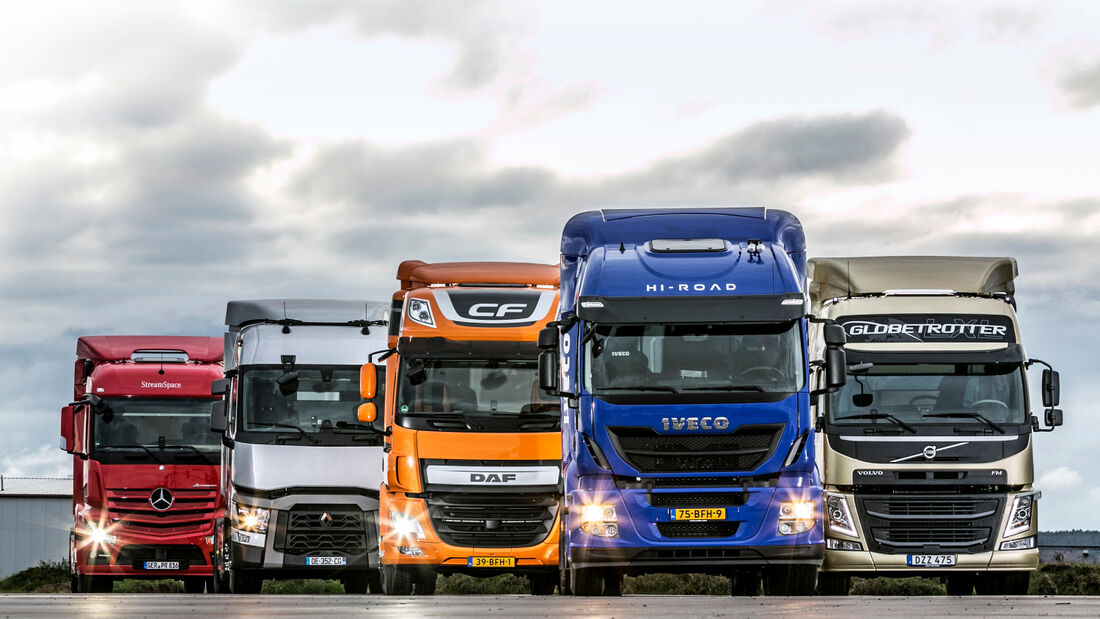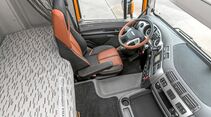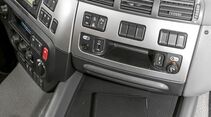If distances aren´t quite as far, if the number of overnight stays in the vehicle is very limited and if the payload is an essential consideration, freight carriers and trucking companies often prefer the DAF CF over the XF, the Volvo FM over the FH or the narrow Mercedes Actros over the wide Actros. This category of slightly smaller long-haul semi-trailer tractors is already well established in many sectors (tank transports, food distribution)—mainly also because these vehicles cost a few thousand less. Another important reason is that the class of compact long-haul semi-trailer tractors now offers enough comfort, power and space to satisfy the drivers too.
This wasn´t always the case. When Renault created this class with its G-series in the early eighties, it mounted a compact and already somewhat aged driver´s cab on a heavy-truck chassis and added a somewhat small, underpowered engine. The result was named the G260 or G290, and it was at best suitable for transporting red wine or fuel along the Rhône valley. It offered some driving comfort and space, but no more than absolutely necessary.
In the mid nineties, Renault then presented the modern and successful interpretation of this topic with its Premium. This motivated all other manufacturers to become active in this segment. Only since then have there been vehicles like the Mercedes Axor (now the narrow Actros), DAF CF, Iveco Hi-Road (alias Eurotech) and Volvo FM.
Few differences with Renault
Curiously enough, Renault of all manufacturers remains only halfheartedly involved in this segment. This is because the T-series introduced in 2013 already possesses a relatively large driver´s cab intended to replace both predecessor series, namely the Magnum long-haul truck and the Premium low-loader trailer tractor. Solely the different mounting heights of the generally bulky driver´s cab—with or without engine tunnel—provide a certain level of class distinction. However, even the low position results in a 1,430-mm-high vehicle floor—a long climb up four steps. Only the Mercedes Actros with its narrow Stream Space driver´s cab significantly exceeds this dimension with 1,525 millimeters.
Even though the Renault T doesn´t quite fit in this setting, it belongs here as the trendsetter in this vehicle category. The other competitors in the test: DAF CF Spacecab, Iveco Stralis Hi-Road, Mercedes Actros Stream Space (2,300 millimeters wide) and Volvo FM Globetrotter LXL. Invited, but failed to appear for whatever reason: Scania with a G Highline and MAN with a TGS.
Compact engines in the tractors under comparison
All manufacturers had also installed compact engines under these driver´s cabs. Although this doesn´t play a big part in the driver´s cab test, it has been an identifying characteristic in this segment since the time of the Renault G-series. Iveco had the smallest engine in the comparison: the Cursor 9 with only around nine liters displacement. Together with the very compact driver's cab, this leads to semi-trailer tractors weighing hardly more than six tons empty. The DAF contender had a 10.8-liter Paccar MX11 under the driver´s cab, and the Mercedes used the slightly smaller OM470 (10.6 liters). Volvo and Renault both used the same 10.8-liter six-cylinder engine from the group, but it is called the D11K at Volvo and the DTI 11 at Renault. Power: 400 hp (Iveco) to 450 hp (Renault and Volvo).
Iveco had not only the smallest engine, but also the smallest driver´s cab in the comparison. Enclosing only 6.9 cubic meters, the driver´s cab of the Stralis Hi-Road is nevertheless well laid out. The Renault T offers 8.3 cubic meters, and the other three competitors lie in between with values from 7.08 to 8.01 cubic meters.
In keeping with the former motto of the concrete industry, it depends on what you make of it, the following also applies here: Sheer size alone is far from being a quality indicator and doesn´t necessarily guarantee a lot of storage space, as demonstrated by Renault´s example. With 690 liters of storage volume, even the compact Iveco offers more space than the 506 liters available in the French vehicle. The rather voluminous Volvo FM with the Globetrotter LXL cab offers only 336 liters in the standard version. This increases to 560 liters with an optional additional rear storage compartment, which is definitely worth the money. This space even has to accommodate the cooler in the FM, because the tall engine tunnel (449 millimeters) leaves no room for it under the bunk bed. Customers wishing to have the cooler in its usual place must order the raised bunk bed. The bunk bed in the test vehicle was mounted as low as possible and left no room for a cooler.
Good compromise from DAF
The DAF CF reaches a good compromise between volume, storage space and freedom of movement, even though the engine tunnel (440 mm) intrudes just as far into the driver´s cab and hinders access to the bunk bed. The generous internal height of more than 2.2 meters (more than in the XF Spacecab), which is still almost 1.8 meters when measured from the top of the tall engine tunnel, permits a raised bunk bed that also works well as a bench and provides plenty of well-organized storage space underneath. The Dutch also provide the CF with an ample and comfortable bunk bed measuring 700 millimeters wide. There is copious room left for a large cooler and practical storage space, because the driver´s cab has a low floor (1,230 millimeters) in addition to the high-mounted bunk bed. The otherwise spacious impression is naturally marred somewhat by the bulky instrument panel center section. Additionally, the lid covering the sole exterior storage compartment on the left side is too small. The obligatory crate of bottled sparkling water won´t fit through it, but this can also be said about the Iveco and Volvo.
The rear of the DAF driver´s cab presents a somewhat antiquated appearance—namely when it comes to the fastening of the hose and cable connections for the semi-trailer when not in use. Instead of the usual support arm there are only a few hooks here, which are furthermore attached to the rear wall. Care is therefore of the essence when tilting the driver´s cab.
If freedom of movement is the only criterion, the Renault makes the best impression—one reason being that the limited storage space leaves a lot of room. Unlike its predecessors, it also appears to be well thought out and clearly organized. And it sometimes borders on being ingenious. For example, with a really good top bunk bed, the front of which can be folded up by 90° in the longitudinal axis. There is a good deal of room behind it to store luggage protected against falling. Renault also offers an attachable backrest behind the passenger´s seat for the lower bunk bed. It looks a bit precarious, but it works and also serves as a pretty comfortable place to rest after the workday.
Renault´s odd choice of colors
By contrast, the color scheme is unconventional. The many shades of gray and silver on and around the instrument panel are OK, but the mud-colored seat covers violently clash with them. Renault also uses this strange-looking brown on the steering wheel. Overall, this looks somewhat cheap and is just as unconvincing as the hard plastic materials used in some areas.
The controls and the ergonomic properties at the workplace provide quite a mixed impression. Take, for example, the three steering-column stalks on the right side, which greatly interfere with each other, or the hidden door module, which additionally lacks mirror-heating controls. Another less than practical feature is a row of switches that is hidden so well that the driver will take ages to find them. A final drawback worth mentioning is the obstructed a-pillar on the right side, which covers an area large enough to make a 7.5-ton truck approaching from the right disappear behind it—not to mention cars or even cyclists. Overall visibility is the best in the Mercedes, followed by the DAF, Volvo and Iveco.
The advantages of the Renault include logically combined switch groups (excluding the aforementioned switch row), a large steering wheel adjustment range, a driver´s seat that can be adapted to any body size, an electronic parking brake control, well-made entry assistants and ladders and—as already mentioned—a roomy drivers cab.
Spacious Actros
The Mercedes Actros Stream Space comes close to matching the spacious impression in the Renault. The somewhat small bodyshell dimensions are compensated for by the high mounting position. The tunnel protrudes only 184 millimeters into the driver´s cab, leaving much room for the driver but slightly limiting the storage space. The well-made interior in this Actros is 476 liters in size, two-thirds of which comprise the roomy outer storage compartments on the left and right. There are also many open storage areas in the sleeping compartment and surrounding the workplace. Overall, the Actros is much roomier than its compact bodyshell (7.08 cubic meters of enclosed space) would suggest. The narrow Actros is a great improvement over its cramped predecessor, the Axor, which was built with all manner of compromise, and it is thoroughly shaking up the competition. It naturally also scores with its uncluttered interior, the high-quality materials and a color scheme that genuinely works, as well as many well-thought-out details like the huge net instead of the top bunk bed. So, if the upper bunk bed isn´t needed, the net provides a lot of open space and a large and very practical open storage area.
The visually striking Actros otherwise completes the first part of the test program, which concentrates exclusively on the static qualities of the driver´s cabs, without attracting much attention. It holds first place together with the Renault, collecting points in all disciplines equally.
The Volvo FM also steadily rakes in points, albeit at a slightly lower level than the Renault and Mercedes. Its weaknesses: The very low-mounted and not particularly tall cab feels slightly cramped, climbing through to the bunk bed is difficult, and the storage compartment brackets over the windshield and on the rear wall restrict the free space and the freedom of movement. It´s also too bad that the FM benefited only partially from the modification of the nearly identical FH cab.
Functional Iveco
Despite its small size, the Iveco manages to perform very well. Storage space and functionality are its strengths. However, compared to its big brother, the Stralis Hi-Way, it lacks available safety equipment. As in the DAF CF, the small size also precludes roomy door panels with cupholders. Iveco solves this problem with two good-sized bottle boxes under the bunk bed and on the right behind the driver´s seat—a good compromise. There is more than enough room next to it for a robust, medium-sized cooler. However, many elegant additions to the interior and controls in the Hi-Way driver´s cab are simply lacking in the Hi-Road.
The test candidates are astonishingly mature in the active part involving driving comfort, handling and controls. Above all the DAF CF demonstrates that there are hardly any restrictions compared to an XF. Its suspension is comfortable, it isn´t fazed by serpentine roads and is amazingly quiet Only the Volvo FM is quieter, and additionally shines with its handling. This is thanks to the precise steering system and the balanced driver´s cab suspension with front coil springs and rear air springs.
With all five tractors, interior noise levels remain low and differ only negligibly from the large driver´s cabs. The winner in this discipline is the Volvo FM, which emits only 63.8 dB(A) when cruising on the highway at 85 km/h. The Renault, Mercedes and DAF are only slightly louder, with noise levels from 64.2 to 64.6 dB(A). Only the Iveco is somewhat of an outlier, with a sound pressure level of 65.1 dB(A). This is naturally because of the relatively low torque of the small engine, which is forced to run at slightly higher revs due to a lower axle ratio. Even at full load on inclines, the interior noise remains at a low level and reaches values of 65.7 (Volvo and Renault) to 67.8 dB(A) for the DAF. However, a rough running engine under load is an annoying drawback of the Renault. The identical engine runs noticeably smoother in the Volvo.
DAF ahead in suspension comfort
The controls in the CF in particular are much improved compared to the vehicle´s predecessor. The engine brake, for example, now operates in three stages and therefore adapts to situations much better than before. The powerful jerk of the single-level brake during activation and deactivation is thus a thing of the past.
If suspension comfort is the only factor, the other four competitors are on about the same level below the DAF. The Renault has a slight edge, but it entered the test with an air-suspended front axle. One feature that stood out was the very smooth, yet precise steering of the Volvo FM (Volvo Dynamic Steering). This truck´s controls could be a bit better, however. The lever for operating the I-Shift is usually on the right of the drive´s seat. Now, the lever in dashboard option is available—both are possible. The best solution would be a lever on the steering wheel, of course, but it is already crowded with them.
The level is relatively uniform and high, apart from these minor drawbacks or strengths. None of the trucks in the quintet is a real outlier. The reason is that these compact long-haul tractors almost always carry the genetic heritage of their respective flagships.
Stralis and FM fail due to the cramped driver´s cab
Mainly considering the controls, the well-designed interior and the low engine tunnel, the Mercedes Actros occupies a top position, which is sufficient overall to put it in first place. The DAF CF is a close second, mainly because it features clear improvements compared to its predecessor, the CF85. It scores with a good interior, a good bed and an equally good storage space design (exception: outer storage compartments), as well as really good driving comfort and handling. The Renault T scored about the same thanks to its sheer size, the related freedom of movement and a just adequate amount of storage space. This score is offset by highly idiosyncratic solutions for the controls and ergonomics, as well as an interior material quality that is below what the competition has to offer
Things are completely different for the Volvo FM, which scores well in all categories but has a low-mounted and quite cramped driver´s cab. This drawback, and the associated lack of storage space, keep it from placing higher in the ranking. The Iveco Stralis, which seems small even in this setting, has a similar problem to the Volvo, is even smaller, but nevertheless performs relatively well—with a lot of storage space, good handling and adequate suspension comfort.









